“Not only can you get your groceries done, but you can have a good meal too,” one visitor says of the new Northgate mercado in Orange County.
- Share via
In 2018, the popular Northgate González supermarket chain announced plans to shutter its downtown Santa Ana store to make way for a development project of apartments and retail space.
It wasn’t the most earth-shattering news for the region, but it was upsetting to many Mexican American families in the heavily Latino seat of Orange County. The downtown Santa Ana Northgate was the first built from the ground up, and the eighth store ever in an empire that has since grown to 44 markets today.
The downtown market, in a chain known for its emphasis on products and ingredients central to Mexican and Latin American cooking, had meaning for the community. But despite protests and a petition signed by close to 400 residents, the downtown Santa Ana Northgate was razed in 2023.
The González family had promised new Northgate markets would help fill the void, and they have made good on that by opening two new markets in Orange County since 2022: a large-format store on Westminster Avenue in Santa Ana and, with much fanfare, the game-changing Mercado González in Costa Mesa late last year.
There’s nothing like it in Southern California. Since opening in November, shoppers and curious eaters have been flocking to the 70,000-square-foot space, marveling upon arrival at its 20 puestos and the first outpost of the famous Churrería El Moro outside of Mexico.
The behemoth of a market has undeniably become a beacon in Orange County. And it’s also reflective of the changing demographics and the realigning politics of a region once largely known for rallying around anti-immigrant political sentiment.
“We wanted to bring to the U.S. something that really was true to a mercado experience,” said Joshua González, project manager for Mercado González and a third-generation Mexican American and member of the González family.
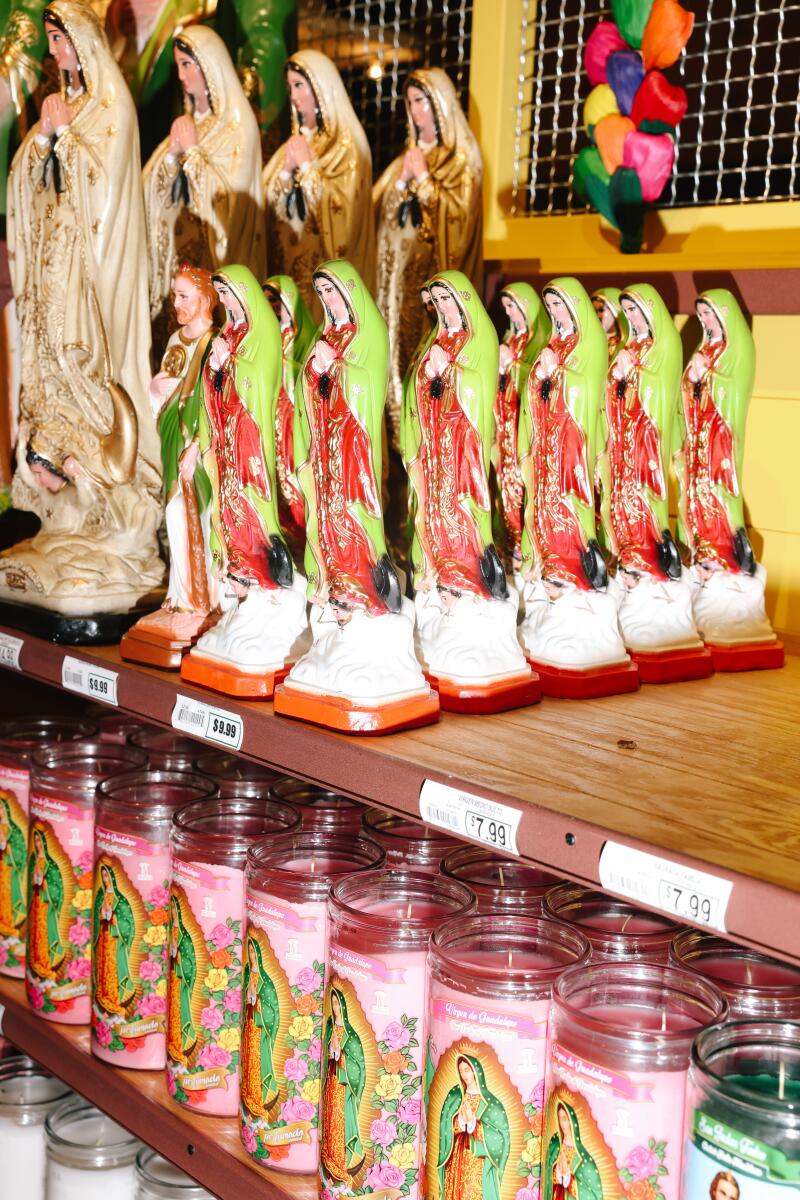
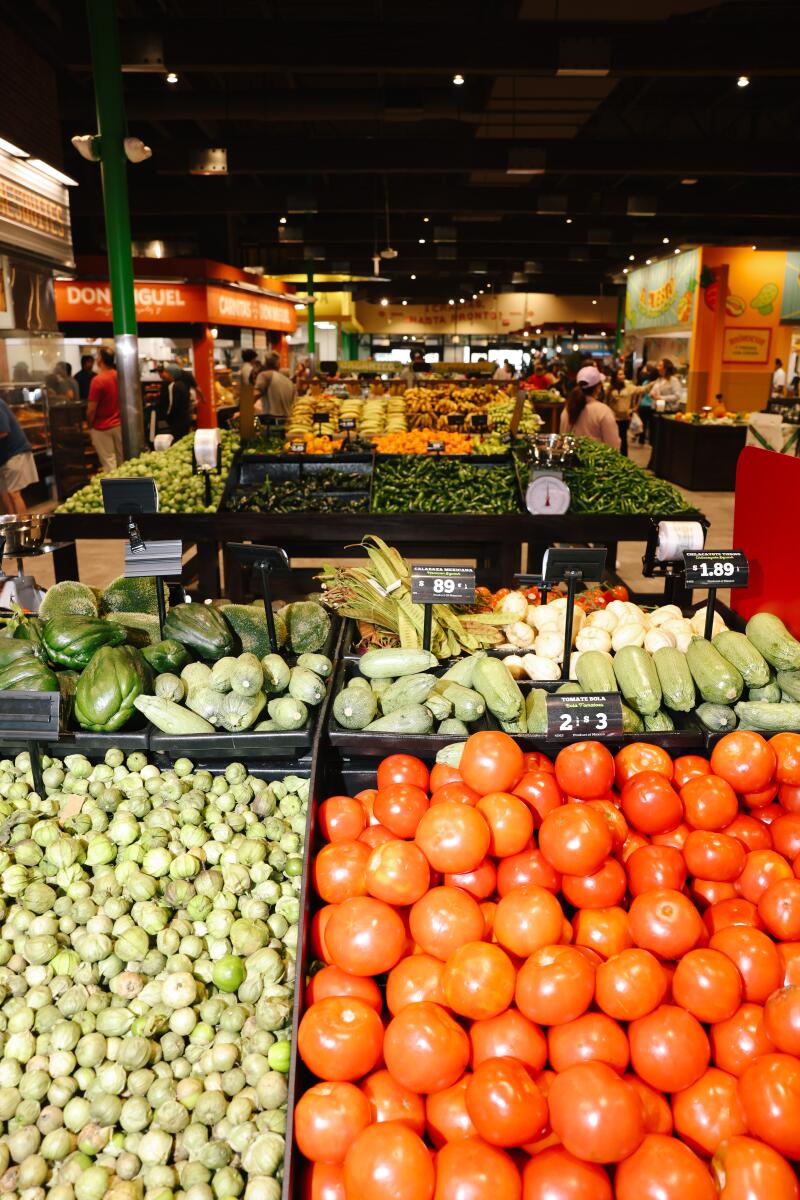
Mercado González has become an outlet for Latino culture.
Orange County spouses Sarah Rafael García and Manuel Galaviz-Ceballos are both professors at Cal State Fullerton and have roots in Mexico. They first visited the market shortly after it opened and immediately saw why it was resonating with locals.
Mercado González on Harbor Boulevard combines a full-service supermarket with a Mexican-style indoor mercado composed of distinct stalls and vendors. Shoppers can stop in for groceries and also walk up to a stall for a fresh torta ahogada or taco al pastor. Tables are scattered about.
“If you were a newly arrived migrant, you could probably go to one of these grocery stores and, first of all, hear your own language,” Galaviz-Ceballos said. “You can eat something that is going to remind you of home and at the same time, build that network and build that community.”
Rafael García is a professor of Chicana/Chicano studies and the founder of LibroMobile Arts Cooperative in Santa Ana. Galaviz-Ceballos is a professor of anthropology who specializes in immigration and the undocumented population. Their visit sparked a conversation about how the market’s innovative concept found itself in a city — Costa Mesa — not usually associated with the Mexican community.
“Driving there, I was a little skeptical because we were like, ‘Why in Costa Mesa?’” Rafael García said.
“I think so often we dismiss other neighborhoods in the region because we are so used to Santa Ana and Anaheim being central to the Latino community in Orange County,” Rafael García said. “I know there are plenty of Latino residents in Costa Mesa and throughout the region.”

Why not Santa Ana?
When Santa Ana College student Lucero Garcia visited Mercado Gonzalez for the first time, she asked herself not only, “‘Why Costa Mesa?’ but also, ‘Why not Santa Ana?’”
Garcia lives in the Spectrum apartments in downtown Santa Ana, across from the former Northgate Market on 4th Street.
“One reason why we lived there was because of Northgate. My parents and a lot of people lived in that housing because there was a grocery store next to them that was also their community,” Garcia said.
Northgate was easily accessible to Garcia and her neighbors, particularly those who don’t drive. The store supplied the guajillo and ancho chiles Garcia’s mother uses to make her salsa.
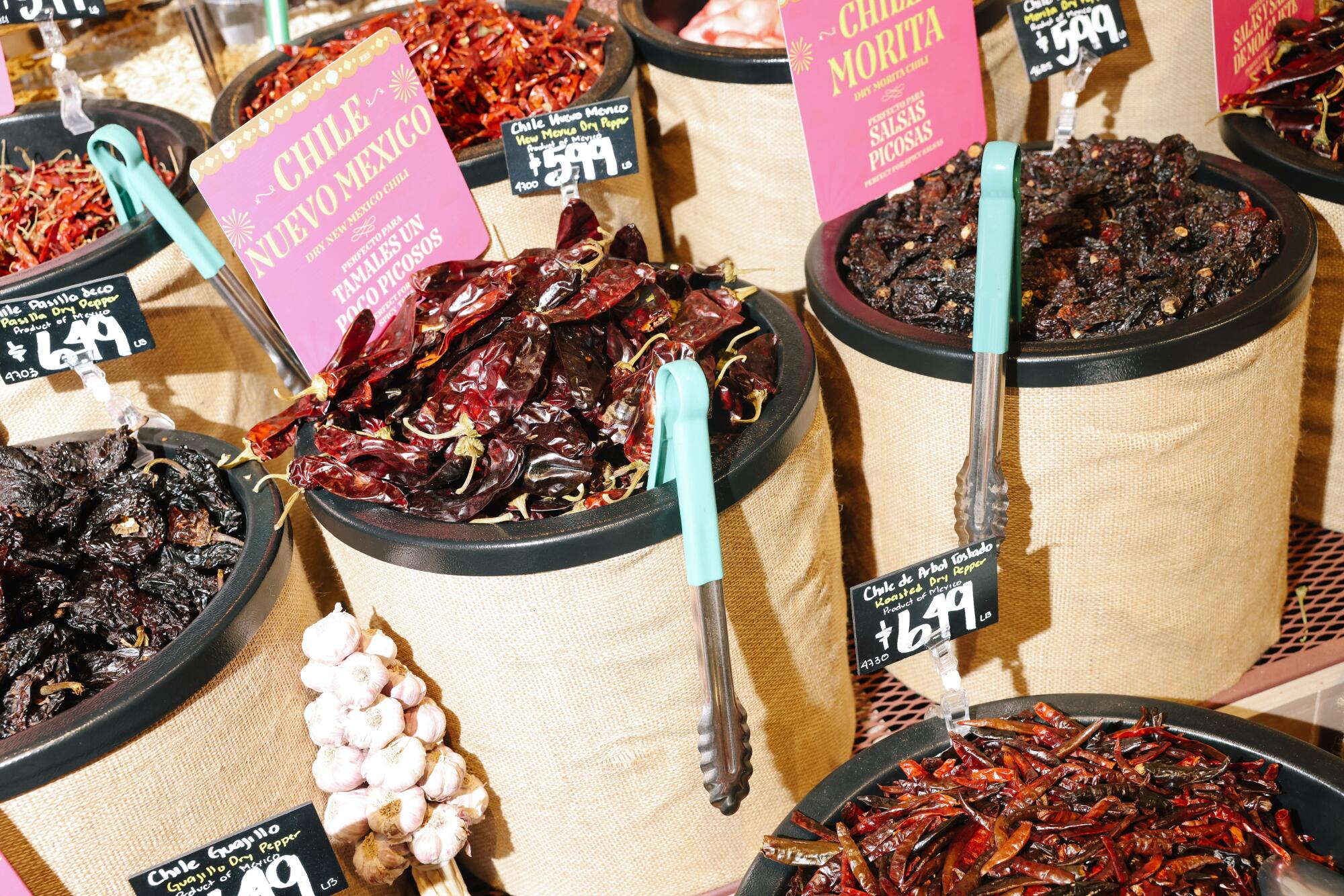
“You can’t find those at Food 4 Less, because it is not curated for a Latino community,” Garcia said.
Northgate González Real Estate partnered with urban redevelopment company Red Oak Investments for the project that will bring apartments and 11,361 square feet of commercial retail space to the former Northgate location. The project moved forward despite pushback from residents who maintained the market served the neighborhood more than additional housing would.
Garcia, who is also a student journalist with Santa Ana College news organization El Don, shared her experience in the student newspaper and documented accounts from her neighbors in a bilingual zine titled “Las Voces de Santa Ana.”
“If they didn’t want to make Mercado González there, why did they not just keep it?” she asks. “Either our market should have stayed or they should have given us the same treatment.”
Orange County Supervisor Katrina Foley, who represents District 5, which includes Costa Mesa, but formerly represented Santa Ana in District 2, said the mercado needed a large space that Santa Ana didn’t have.
“There really isn’t a space that is as big as this Mercado on 4th Street,” Foley said.
Costa Mesa Mayor John Stephens pointed to the city’s central location.
“From a transportation standpoint, we are the northern terminus of the toll roads of the 73 Freeway,” Stephens said. “We are now the southernmost terminus for the new lanes on the 405 Freeway. We are right in the center of everything.”
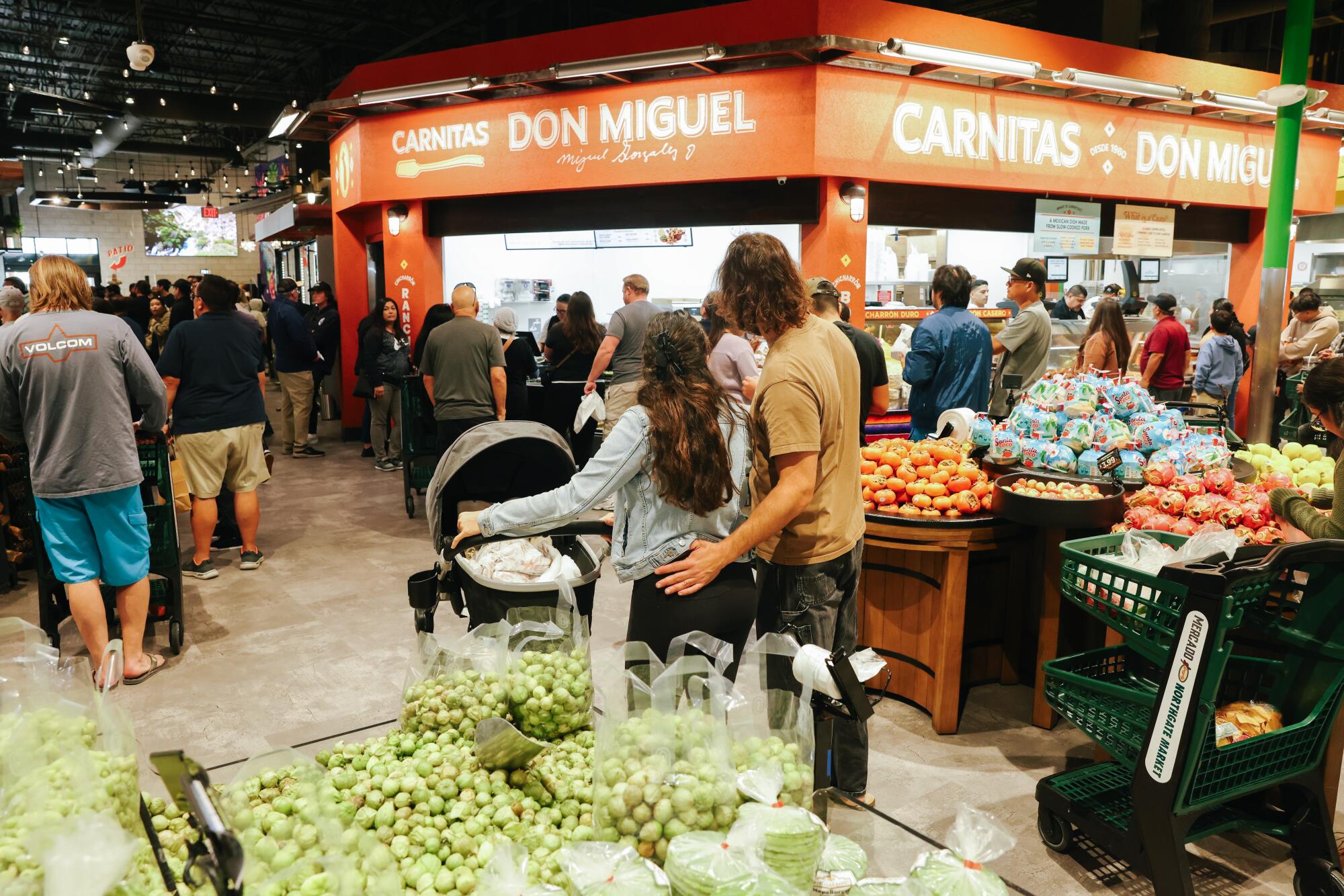
While Costa Mesa’s central location was attractive, project manager Joshua González said they were confident the mercado would be a destination wherever it was. “We believed that this mercado would draw people from near and far, whether it was Santa Ana or Orange or Laguna or Newport. We thought that people would make the drive to experience it.”
But for Santa Ana residents like Garcia, driving to Costa Mesa to visit Mercado González was bittersweet.
“It was really nice; you walk in and you see this community,” Garcia said. “But seeing that was also very sad, because it is not in my community anymore. I can’t just walk down the street and experience this again.”
As a Santa Ana business owner, Rafael García said she understands how Santa Ana residents like Garcia must feel. There are still Northgate Market locations in Santa Ana, but none in downtown.
“I am sure that people who really relied on the Northgate in downtown have that feeling of abandonment when they encounter Mercado González,” Rafael García said. “It is hard to step into other places becoming new placements for something that felt like home.”
The area has experienced challenges, broadly with gentrification and more specifically with the disruption caused by the construction of the OC Transportation Authority’s $509-million rail project.
“Santa Ana is a fabulous city and it is getting better and better every day,” Foley said. “Fourth Street is going to come back and there are a lot of people working to make sure that happens.”
She also emphasized Costa Mesa’s proximity to Santa Ana.
“People from Santa Ana can come shop in Costa Mesa; it’s not that far away,” Foley said. “The bus goes right there.”
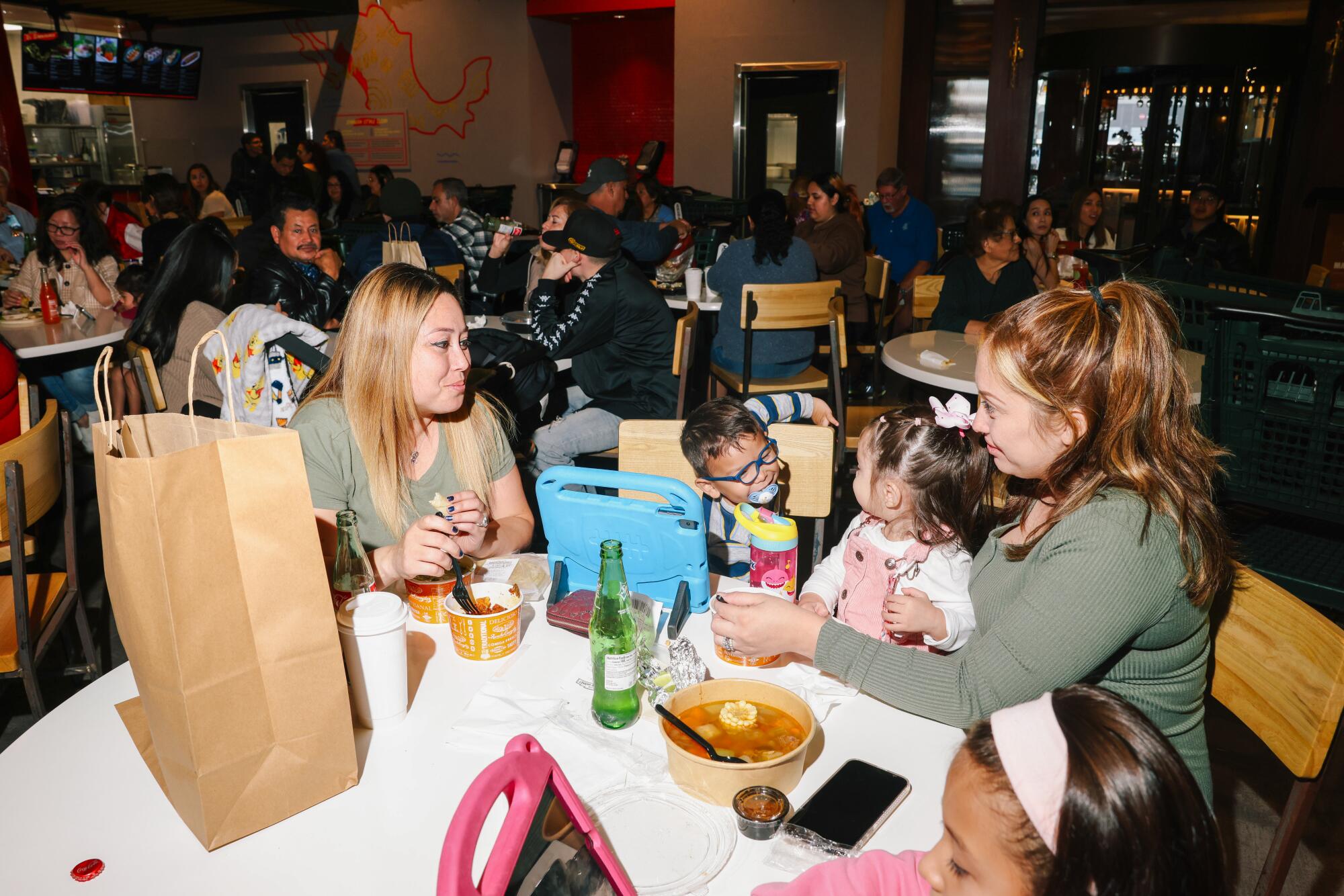
Serving the community
Mercado González is drawing a multicultural crowd, not just Latinos. The space also features a bar serving contemporary cocktails and a high-end restaurant concept called Maizano with its own on-site corn mill.
Husband and wife Alex Hardy and Camille Krahe Hardy were impressed with the market as they shopped with their 14-month-old son.
“We knew that this was coming but just didn’t realize the scale that they were trying to pull off,” Alex said.
Nearby, Jazmin Vargas sat at a table enjoying chorizo con papas with her children, sister and niece. The family traveled from Anaheim to shop and try the different food options.

“When you come with a big family, not everyone wants the same things; I like the options,” Vargas said. “Not only can you get your groceries done, but you can have a good meal too.”
The first Northgate Market opened in 1980 in Anaheim, founded by Don Miguel and Doña Teresa González. Today, the business is run by 13 González children, and the sprawling Mercado González is mainly the work of third-generation family members like Joshua González, who spearheaded the project along with Tom Herman, Northgate Market’s senior vice president.
Jody Agius Vallejo, a USC sociology professor who studies immigration integration and Latino issues in Orange County, believes Mercado González’s location in Costa Mesa was a smart move to expand their consumer base beyond the traditional Latino markets.
“You’ve got this shift in Latinidad but also the ways in which you see ethnic consumerism going beyond the Latino community,” Agius Vallejo said. “They are not solely relying on Latinos to maintain this store.”
While other Northgate Markets were designed with Latino shoppers in mind, Mercado González is meant to be a destination for everyone.
“We did not have a specific demographic or audience in mind but rather creating an experience that could be shared by all,” González said. “By all age groups and families.”
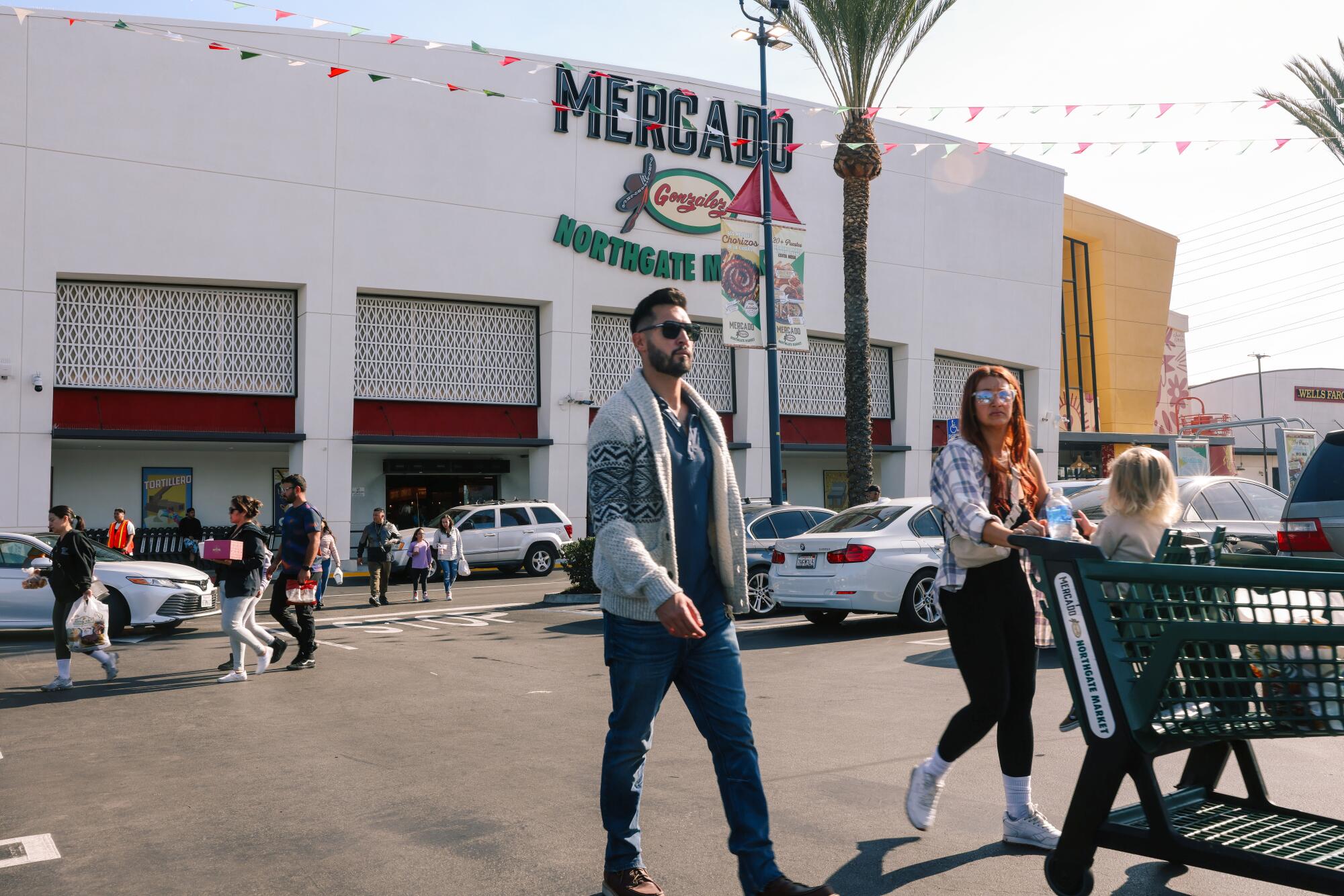
Shifting politics
Foley and Stephens were among the city officials and community business leaders present for a preview of the market in November. Expectations were high.
“There is really nothing like it in Orange County or probably even California, and we are very, very pleased that it is in the city of Costa Mesa,” Stephens said.
Latinos make up 36.2% of the city’s population, according to the latest U.S. Census data.
There has always been a Latino presence in Costa Mesa, but there was a time when some Latinos may not have felt as welcomed in the city. As the Latino population grew in the mid-2000s, there was a backlash from local conservatives that “created a very hostile context not just for the Latino immigration population but for their children as they came of age,” Agius Vallejo said.
By 2006, Costa Mesa city officials had taken an aggressive stance against illegal immigration by implementing a series of policies meant to target people in the country without legal status. Many of these efforts were created by a core group of conservatives on the City Council, led by Alan Mansoor, who aligned himself with far-right militia group the Minuteman Project.

Additionally, city leaders implemented policies that targeted day laborers and pushed for a program to deputize police officers to perform immigration enforcement.
“People would say, ‘Don’t drive in Costa Mesa. Stay out of Costa Mesa,’” Agius Vallejo said. “During that time, the city was very much known as inhospitable and dangerous for Latinos, especially people who may lack a driver’s license or even somebody who didn’t want to get pulled over or racially profiled.”
In 2018, the Costa Mesa City Council pivoted from being majority Republican to Democrat and Manuel Chavez, Andrea Marr and Arlis Reynolds became the first Latinos elected to the council. It was part of a larger political shift in Orange County, where Democrats swept all congressional seats representing county residents, flipping four of them after longtime Republican control.
Currently, Orange County counts more registered Democrats than Republicans.
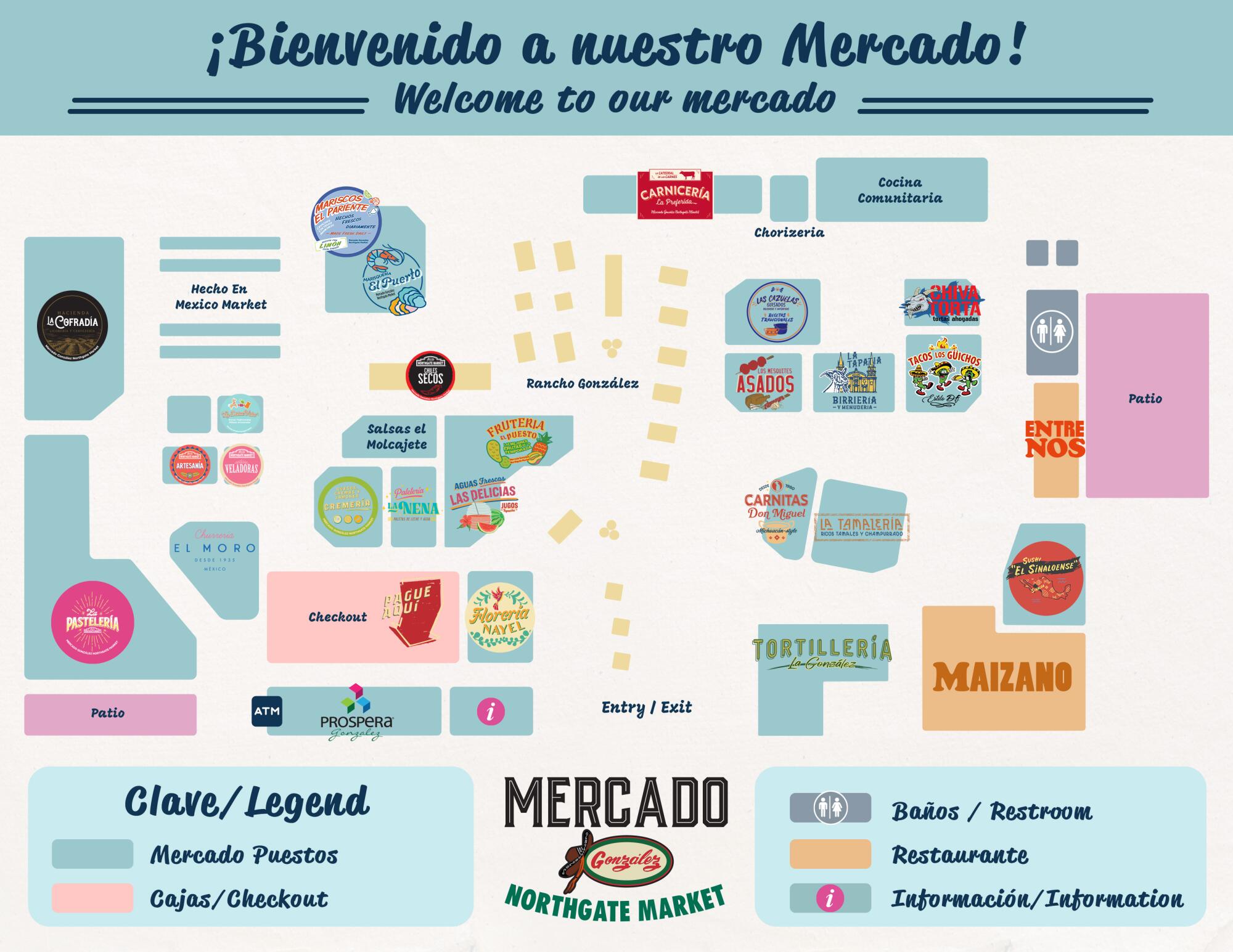
Today, Latinos from all over Southern California are driving to Costa Mesa to visit Mercado González. The turnaround is astounding for many.
Isabel Gomez, Rita Gomez and Fermin Ramirez traveled from Monterey Park and Chino to visit the market. The family said it was their first time in Costa Mesa, and worth the drive.
“We love the food, all the staff here is extremely friendly and they explain everything in English and in Spanish,” Isabel said as the group sipped coffee and snacked on churros. “We will be back.”
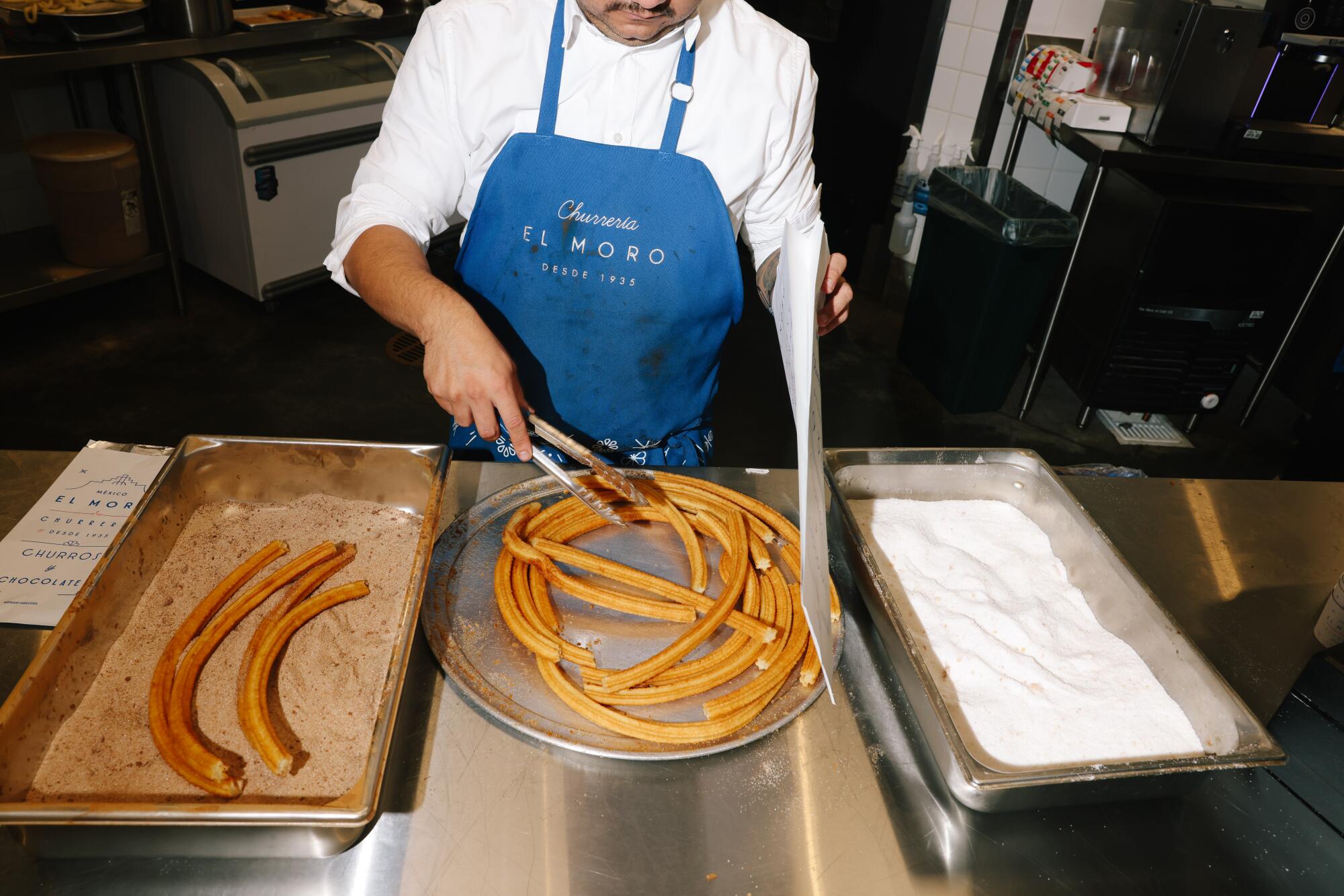
Bienvenido a Costa Mesa
In the planning and construction of Mercado González, the Northgate team found an ally rather than an enemy in the Costa Mesa City Council.
“The city has been tremendous in supporting us and helping us through the process,” Joshua González said. “The mayor’s office and the planning commission supported many parts of our project.”
Stephens said when the project went before the planning commission, the proposed plan included televisions on the patio and hours that permitted the market to serve breakfast.
“They also wanted to have live music; those aspects were not approved. So I brought that up from the planning commission to the City Council and the City Council approved it on a 7-0 vote that they should get those additional entitlements,” Stephens said.
Mercado González also is responsible for drawing other businesses into Costa Mesa, like Churrería El Moro, the legendary Mexico City churro shop. Santa Ana-based concept Chiva Torta also can be found at Mercado González, selling the Guadalajara-style torta ahogadas that made the food truck a fixture on North Spurgeon Street near the former 4th Street Northgate.
Rafael García said spotting Chiva Torta felt like the González family went out of its way to represent the community and make space for a business that might have been displaced by the closure of 4th Street’s Northgate.
“When I saw them there, I put my fist up in the air and was like, ‘Yes, thank you for not forgetting who was outside your markets,’” said Rafael García. “That gave me a lot of pleasure.”
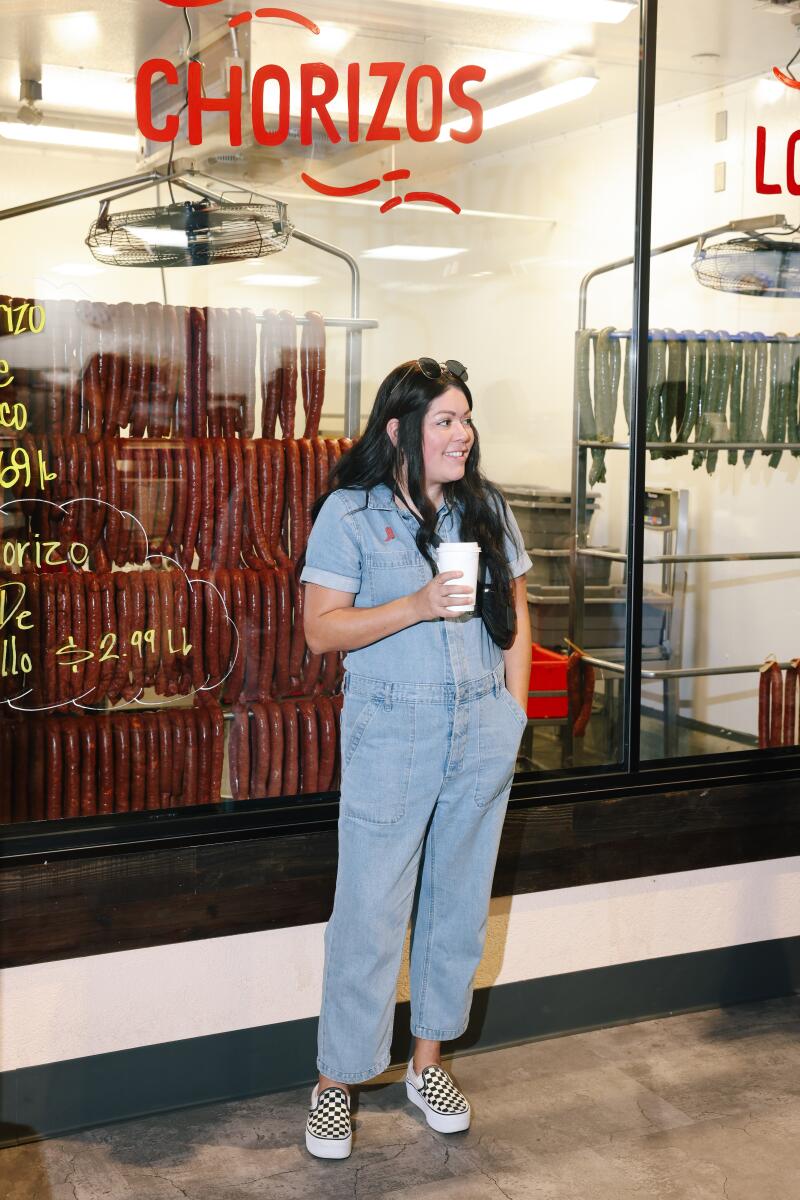
Corinne Mosqueda waits for her food order.
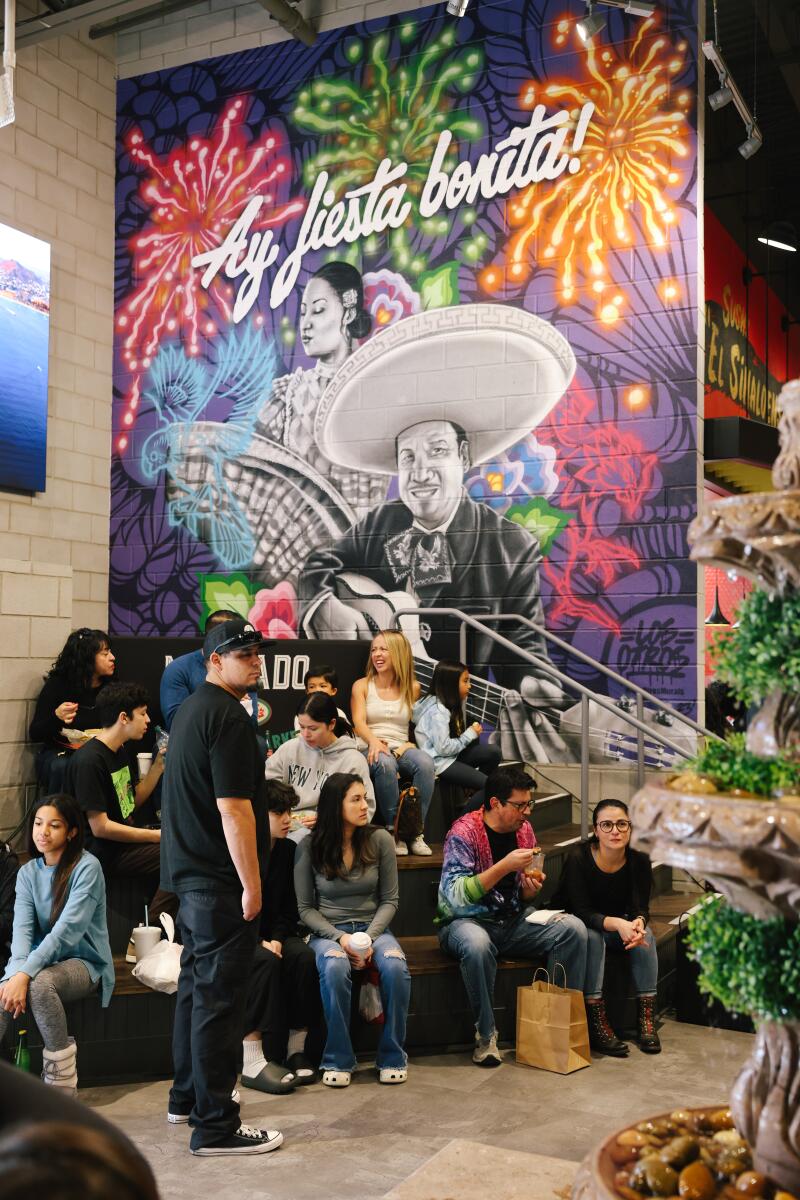
People hang out at Mercado González.
A place to gather
Although she had her initial doubts about the market working in Costa Mesa, Rafael García said she felt her skepticism dissipate once she entered Mercado González.
“The moment I walked in, I couldn’t stop repeating over and over that this concept is genius,” said Rafael García. “We shouldn’t be surprised because it is something that our culture has always done. No matter where you visit in Mexico, there is a mercado. For once, there is a place that is being created for and by our community.”
The market’s presence in Costa Mesa also pushes back on stereotypes. “It disrupts the notion that all Mexicans or all Latinos live in Santa Ana, ” Galaviz-Ceballos said.
The authenticity of the culture is something the customers feel too. “If you want a taste of México, ven para acá,” said Isabel Gomez. Come here, she said.
More to Read
Eat your way across L.A.
Get our weekly Tasting Notes newsletter for reviews, news and more.
You may occasionally receive promotional content from the Los Angeles Times.













